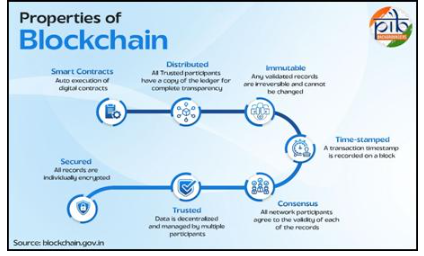Building Trust, Transparency, and Technological Sovereignty
Introduction:
Ministry of Electronics and Information Technology (MeitY) launched the National Blockchain Framework (NBF) in September 2024 with an outlay of ₹64.76 crore. The framework establishes a unified architecture for blockchain-based governance solutions, ensuring secure, scalable, and verifiable digital transactions across sectors.
What is Blockchain?
Blockchain is a distributed digital ledger where records are stored securely across multiple nodes, making tampering nearly impossible. It ensures transparency, immutability, and trust, which are crucial for governance.
Types of Blockchain
1. Public Blockchain: Open to all but ensures full transparency.
2. Private Blockchain: Access restricted to authorized participants & ideal for government use.
3. Consortium Blockchain: Jointly managed by multiple institutions.
4. Hybrid Blockchain: Combines features of both public and private systems for selective transparency.

National Blockchain Framework (NBF):
National Blockchain Framework launched in September 2024 builds upon MeitY’s Digital India vision to provide a unified digital backbone for governance. It promotes interoperability, data integrity, and citizen trust through decentralised technologies.
Core Components of NBF
1. Vishvasya Blockchain Stack
-
- Indigenous, modular, Blockchain-as-a-Service (BaaS) platform.
- Deployed across NIC data centres (Bhubaneswar, Pune, Hyderabad) ensuring scalability and resilience.
- Permissioned blockchain layer: Only verified participants can validate transactions.
- Open APIs enable seamless integration with e-governance systems.
2. NBFLite – Sandbox for Startups and Academia
-
- A sandbox platform for innovation and experimentation.
- Enables startups and students to prototype blockchain applications.
- Offers smart contract templates in governance areas like digital certificates, supply chain, and public data management.
3. Praamaanik – App Verification Solution
-
- Ensures mobile application authenticity using blockchain records.
- Prevents fraudulent apps and protects user data.
- Strengthens trust in the digital ecosystem by verifying app sources securely.
4. National Blockchain Portal
-
- Central platform for knowledge sharing, standardization, and cross-sector collaboration.
- Showcases India’s blockchain projects and acts as a hub for innovation and policy coordination.
Blockchain Uses Transforming Governance:
| Chain Type | Description & Achievements |
|---|---|
| Certificate Chain | Secure storage and verification of certificates (e.g., CBSE academic records). |
| Document Chain | Unified platform for government-issued documents—caste, ration card, driving license, etc.; 48,000+ documents verified. |
| Property Chain | Transparent property transaction system ensuring verifiable ownership; 34 crore property documents verified. |
| Logistics Chain | Tracks goods through tamper-proof ledgers. Aushada (Karnataka) uses blockchain for drug supply monitoring and patient safety. |
| Judiciary Chain | Facilitates secure e-delivery of summons, bail orders, and case documents; 665 judiciary documents verified. |
| Inter-Operable Criminal Justice System (ICJS) | Integrates police, courts, and prisons digitally; 39,000+ documents verified on blockchain. |
Regulatory & Institutional Ecosystem
1. Centre of Excellence (CoE) in Blockchain Technology
-
- Set up by National Informatics Centre (NIC).
- Provides consultancy, pilot development, and training for government departments.
- Uses Hyperledger Sawtooth, Fabric, and Ethereum for building secure networks.
2. Role of Telecom Regulatory Authority of India (TRAI)
-
- Integrated Distributed Ledger Technology (DLT) for SMS and telecom regulation.
- Over 1.13 lakh entities onboarded, reducing spam and ensuring message authenticity.
3. Role of Reserve Bank of India (RBI)
-
- Implemented Digital Rupee (e₹) pilot using blockchain.
- Demonstrates traceable, instant, and transparent transactions within closed networks.
4. NSDL’s Blockchain Platform
-
- Introduced DLT-based Debenture Covenant Monitoring.
- Enables secure tracking of asset cover ratios and investor data through tamper-proof ledgers.
Capacity Building and Skill Development:
Ministry of Electronics and Information Technology (MeitY) has launched several capacity-building programmes focused on blockchain. These initiatives aim to create a future-ready workforce, which are as follows-
-
- 214+ training programmes conducted for 21,000+ government officials under MeitY’s Capacity Building Division.
- Post Graduate Diploma in FinTech & Blockchain Development (PG-DFBD): 900-hour course on Blockchain, FinTech, AI, ML, and cybersecurity.
- BLEND (C-DAC Online Course): Builds conceptual and applied knowledge for students and professionals.
- FutureSkills PRIME: Industry-oriented re-skilling programme covering 10 emerging technologies including blockchain.
The NBF paves the way for a trust-based digital economy, with ongoing Proof-of-Concepts (PoCs) in key areas:
-
- Land Records: Tamper-proof ownership and transaction history.
- Blood Bank: Transparent donation and distribution tracking.
- GST Chain: Real-time tax transaction monitoring.
- Public Distribution System (PDS): End-to-end traceability for ration delivery.
Limitations & Challenges
-
- According to the draft strategy of Niti Aayog, India suffers from a shortage of technical expertise and evangelists for blockchain.
- In practice, running blockchain at national scale across diverse domains (certificates, property records, supply chain) requires high transaction throughput and low latency.
- Blockchain’s redescription by the state suggests “recentralising effects where the state, reinvents itself as an intermediary”.
- It demands capital & connectivity, especially in rural/remote areas and regular maintenance.
- Bureaucratic resistance, fear of job displacement, and lack of awareness are other challenges.
However, with its decentralized and interoperable design, the NBF sets the stage for India’s transition to blockchain-enabled e-governance, enhancing efficiency and citizen confidence.
Conclusion:
The National Blockchain Framework exemplifies India’s journey toward a trusted digital state—where governance is transparent, secure, and citizen-centric & advancing its vision of Digital India and Aatmanirbhar Bharat.
Spread the Word
